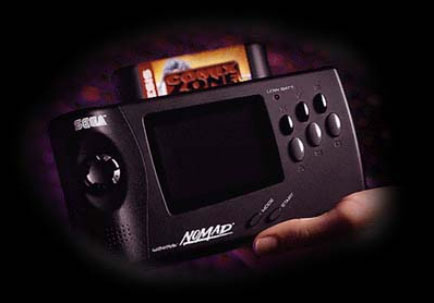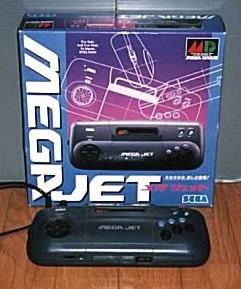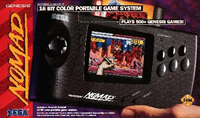Until only recently, it was considered foolhardy at best for a company to take on Nintendo in the portable market. Their beloved Game Boy plowed through each and every competitor with merciless abandon, no matter how much money or  advertising they had. NEC was burned with their Turbo Express, Atari with its Lynx, and Sega with its own Game Gear. Yes, it seemed that no one could dethrone the undisputed king of the mountain. The Game Boy was invincible.
advertising they had. NEC was burned with their Turbo Express, Atari with its Lynx, and Sega with its own Game Gear. Yes, it seemed that no one could dethrone the undisputed king of the mountain. The Game Boy was invincible.
So then why the hell would Sega release yet another portable?
Ah, such is the nature of the hardware business. When the Nomad made its debut in October of 1995, the House of Sonic sincerely had hopes that it would be the hardware that would finally give it a foothold in the portable market. Instead, they saw yet another machine die a premature death.
Looking Back
Taking a look at the facts now, Sega’s decision certainly doesn’t seem to make much sense. Back in 1995 though, it was quite a different story. The Genesis was highly successful, and Sega was hard at work trying to make headway with its two add-ons, the Sega CD and 32X. Management probably figured that the timing was right for a second swing at the Game Boy. It wasn’t like they had to start from scratch, either. The Nomad had been in development essentially since 1992, and was itself based off the Mega Jet – a screenless, portable version of the Mega Drive used for promotion with Japan Air Lines. Sega seemingly thought that they only had to add was an LCD screen and some battery power, and things were good to go. Presently, we know that the battery life is enough to make or break a portable. Sega, unfortunately, didn’t learn their lesson from the Game Gear debacle, which practically required you to hook up your car battery or home generator just to power the damn thing up. I still remember the lights in my building dimming every time the kid down the hall used the damn AC adapter.
We should be more fair than that though. The Nomad actually had some cool features, like being able to plug in a Genesis pad, or connect to the TV for standard console-like play. It was also cool that you had a library of over seven hundred games right out of the box. The backlit screen was also very nice and was a far cry from the standard monochrome dullness that was the Game Boy screen. There was a small issue with blurriness with some games, but that was a common problem at the time with handhelds. The unit was also sexy as hell, much smaller than the mammoth Game Gear, and also boasted full stereo sound and full six-button control.
 Sounds like a winner, huh? Not at all. Aside from the battery life problem, the Nomad was also incompatible with the 32X, Power Base Converter, and Sega CD. This meant that you were more or less getting half a product with a nice screen. Sega was having a heck of a time trying to convince the public to spend cash on their 16-bit transformer, and offering a portable that used none of it was something of a turn off. The $180 price tag didn’t help either, and gamers took their piggy banks over to Sony’s kiosks instead.
Sounds like a winner, huh? Not at all. Aside from the battery life problem, the Nomad was also incompatible with the 32X, Power Base Converter, and Sega CD. This meant that you were more or less getting half a product with a nice screen. Sega was having a heck of a time trying to convince the public to spend cash on their 16-bit transformer, and offering a portable that used none of it was something of a turn off. The $180 price tag didn’t help either, and gamers took their piggy banks over to Sony’s kiosks instead.
This is all common knowledge though. What we want to address here is why Sega made such a bad move by going back into the portable market. That is the issue which has been debated by Segaphiles for a decade now, and it is time that Sega-16 chimed in with its two cents.
Our Verdict?
So, should Sega have released the Nomad? Quite frankly, our answer is a resounding “NO!” Let me show you why.
- Too much going on at one time. I know that hindsight is 20/20, and I know that all the cues were there at the time to take another crack at Nintendo. What remained seemingly unbeknownst to Sega, unfortunately, was the overwhelming reality that they were stretching themselves far too thin. The Genesis, Sega CD, 32X, and Saturn were all on shelves simultaneously, before the Nomad even shipped. Although things were looking good for the main console, there was another generation of hardware already making its debut, and the Genesis was beginning to show its age. Everything else, Saturn included, was still struggling to get a foothold in the market. How could Sega have possibly thought that releasing more hardware would be a good idea?
- Sega of Japan was run by people who knew little of the American market. Ok, let me see if I understand this. After saturating the market with hardware, you just up and decide to discontinue everything in favor of a console that went on to have barely 7% of the market share the Genesis did. Everyone knows the Saturn had an uphill battle since it was still in development, and Nakayama’s controversial decision to scuttle everything in favor of it was a corporate bullet to the head of Sega’s 16-bit bread and butter.
- None of the Game Gear’s major problems were corrected. Truly sad battery life from a vampiric back-lit screen was what basically killed Sega’s first handheld. Why on Earth would you not rectify the problem with the new hardware, especially when it was more powerful? Six, yes six AA batteries gave you anywhere from 4-6 hours of play. Not a lot for those platformers and RPGs.
- No compatibility. I can’t use my 32X with it? That would have been ugly as hell, but a redesign could have fixed that. Sega CD is a no-go too, eh? Umm, why don’t I just buy a CDX instead?
- No imagination. How cool would it have been if you were able to play your Master System games on the Nomad? It is unclear whether or not it had a Z80 processor, but if it did, why not use it? It’s sad that the converters and carts released for this sort of thing come from unlicensed hackers and such. Even the battery pack was mediocre and underwhelming. I don’t have to mention how annoying it was to accidentally knock out a battery when playing.
- It was simply too expensive. $180 seems too much to pay for a handheld now, can you imagine how it must have looked a decade ago? This for a system that included no games and forced you to purchase a separate battery pack just to get some decent play time.
Sega Nomad = Folly
 I know, I know. You really want to love this little handheld. I do too. The facts, however, are undeniable. Sega made a huge mistake by taking it to market when they did, and it never really had a chance against the Game Boy’s Energizer Bunny-like battery prowess and massive library. Had they forgone the Sega CD and 32X in favor of the Nomad, things might have turned out different. We could spend all week arguing hypotheticals though, and the reality is what it is. Still, the Nomad is a neat little collectible that is readily available in the U.S. (its proposed European and Japanese launches were canceled when it tanked in America), but it will cost you some coin.
I know, I know. You really want to love this little handheld. I do too. The facts, however, are undeniable. Sega made a huge mistake by taking it to market when they did, and it never really had a chance against the Game Boy’s Energizer Bunny-like battery prowess and massive library. Had they forgone the Sega CD and 32X in favor of the Nomad, things might have turned out different. We could spend all week arguing hypotheticals though, and the reality is what it is. Still, the Nomad is a neat little collectible that is readily available in the U.S. (its proposed European and Japanese launches were canceled when it tanked in America), but it will cost you some coin.
My recommendation is to find one if you can and enjoy it for what it is. The Nomad makes a fine collectible and is great for playing when you don’t have a TV near. Just make sure you have the AC adapter, or you’ll be spending some serious cash on batteries.
For more information about which games work best, check out our Nomad Buyer’s Guide and feel free to contribute!

Ok, I have to say that the complain about the lack of addon compatibility was asinine.
Of course the addons aren’t compatible! They were designed for a home console, not a handheld system. There’s no freaking way they could have made the Nomad compatible with them without giving it an atrocious design. They would have had to put the cartridge slot higher to make the 32X compatible, which would have meant the catridges would have stuck out even more and it would have been easy for them to be knocked out. And the Sega CD being compatible is out of question, considering that it would require the Nomad to have the exact same shape as the Genesis!
If the Nomad and the 32X had been more successful, Sega could have released a new 32X model specifically designed for the Nomad, just like they created a new Sega CD model for the Genesis 2. But the Sega CD would still be out of the question; there’s no darn way it wouldn’t have been too bulky for a handheld with those large CD-ROMs.
Expecting the Nomad to be compatible with the Sega CD and the 32X is ridiculous. It’s not the latest model of the Genesis; it’s a handheld game designed to play Genesis games instead. You should have known by default that it wouldn’t be identical to the Genesis nor would have had all of its functions.
Not to mention that over 90% of Genesis owners don’t own or care about those addons.